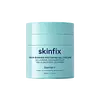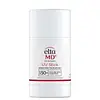What's inside
What's inside
 Key Ingredients
Key Ingredients

 Benefits
Benefits

 Concerns
Concerns

No concerns
 Ingredients Side-by-side
Ingredients Side-by-side

Water
Skin ConditioningSqualane
EmollientPropanediol
SolventJojoba Oil/Macadamia Seed Oil Esters
Skin ConditioningTriheptanoin
Skin ConditioningNiacinamide
SmoothingSaccharide Isomerate
HumectantAmmonium Acryloyldimethyltaurate/Vp Copolymer
Squalene
EmollientZinc PCA
HumectantHydrolyzed Hyaluronic Acid
HumectantGlycerin
HumectantCamellia Sinensis Seed Extract
HumectantAllantoin
Skin ConditioningPhytosteryl Macadamiate
Skin ConditioningPhytosterols
Skin ConditioningAcetyl Glutamine
Skin ConditioningLecithin
EmollientCaprylyl Glycol
EmollientAmylopectin
Sodium Hyaluronate
HumectantFolic Acid
Skin ConditioningOligopeptide-3
Skin ConditioningBacillus/Soybean Ferment Extract
Skin ConditioningOligopeptide-1
Skin ConditioningOligopeptide-2
Skin ConditioningHexapeptide-11
Skin ConditioningTocopherol
AntioxidantLithothamnion Calcareum Extract
Skin ConditioningLactic Acid
BufferingGlucose
HumectantAcetyl Heptapeptide-4
HumectantC14-22 Alcohols
Emulsion StabilisingC12-20 Alkyl Glucoside
EmulsifyingEthylhexylglycerin
Skin ConditioningTrisodium Ethylenediamine Disuccinate
Potassium Sorbate
PreservativeCitric Acid
BufferingSodium Citrate
BufferingPentylene Glycol
Skin ConditioningSodium Benzoate
MaskingXanthan Gum
EmulsifyingPhenoxyethanol
PreservativeWater, Squalane, Propanediol, Jojoba Oil/Macadamia Seed Oil Esters, Triheptanoin, Niacinamide, Saccharide Isomerate, Ammonium Acryloyldimethyltaurate/Vp Copolymer, Squalene, Zinc PCA, Hydrolyzed Hyaluronic Acid, Glycerin, Camellia Sinensis Seed Extract, Allantoin, Phytosteryl Macadamiate, Phytosterols, Acetyl Glutamine, Lecithin, Caprylyl Glycol, Amylopectin, Sodium Hyaluronate, Folic Acid, Oligopeptide-3, Bacillus/Soybean Ferment Extract, Oligopeptide-1, Oligopeptide-2, Hexapeptide-11, Tocopherol, Lithothamnion Calcareum Extract, Lactic Acid, Glucose, Acetyl Heptapeptide-4, C14-22 Alcohols, C12-20 Alkyl Glucoside, Ethylhexylglycerin, Trisodium Ethylenediamine Disuccinate, Potassium Sorbate, Citric Acid, Sodium Citrate, Pentylene Glycol, Sodium Benzoate, Xanthan Gum, Phenoxyethanol
Zinc Oxide 22%
Cosmetic ColorantCaprylic/Capric Triglyceride
MaskingHelianthus Annuus Seed Wax
Skin ConditioningCetearyl Nonanoate
EmollientTheobroma Cacao Seed Butter
EmollientButyloctyl Salicylate
Skin ConditioningLauryl Laurate
Skin ConditioningPolyhydroxystearic Acid
EmulsifyingEuphorbia Cerifera Wax
Capryloyl Glycerin/Sebacic Acid Copolymer
Skin ConditioningMica
Cosmetic ColorantBehenyl Behenate
EmollientButyrospermum Parkii Butter
Skin ConditioningOryzanol
Skin ConditioningEthyl Ferulate
AntioxidantIsostearic Acid
CleansingLecithin
EmollientPolyglyceryl-3 Polyricinoleate
EmulsifyingBisabolol
MaskingTocopherol
AntioxidantSilica
AbrasiveZinc Oxide 22%, Caprylic/Capric Triglyceride, Helianthus Annuus Seed Wax, Cetearyl Nonanoate, Theobroma Cacao Seed Butter, Butyloctyl Salicylate, Lauryl Laurate, Polyhydroxystearic Acid, Euphorbia Cerifera Wax, Capryloyl Glycerin/Sebacic Acid Copolymer, Mica, Behenyl Behenate, Butyrospermum Parkii Butter, Oryzanol, Ethyl Ferulate, Isostearic Acid, Lecithin, Polyglyceryl-3 Polyricinoleate, Bisabolol, Tocopherol, Silica
 Reviews
Reviews

Ingredients Explained
These ingredients are found in both products.
Ingredients higher up in an ingredient list are typically present in a larger amount.
Lecithin is a term for a group of substances found in the cell membranes of plants, animals, and humans. They are made up of mixture of phospholipids.
This ingredient has emollient and emulsifying properties.
As an emollient, lecithen helps soften the skin and creates a barrier to keep moisture in.
As an emulsifier, it also helps prevent water and oil ingredients from separating. Lecithin can also help ingredients be better absorbed by the skin.
This is because the phospholipids in lecithin produce liposomes. Liposomes help other ingredients get through the skin barrier.
Depending on the source of this ingredient, lecithin may not be fungal acne safe. This is because some sources of lecithin come from soybean oil, which may feed the malassezia yeast that feeds fungal acne.
We recommend reaching out to the brand you are purchasing from to inquire about the source of their lecithin.
Some other names for this ingredient include soy lecithin and deoiled soy lecithin.
Learn more about LecithinTocopherol (also known as Vitamin E) is a common antioxidant used to help protect the skin from free-radicals and strengthen the skin barrier. It's also fat soluble - this means our skin is great at absorbing it.
Vitamin E also helps keep your natural skin lipids healthy. Your lipid skin barrier naturally consists of lipids, ceramides, and fatty acids. Vitamin E offers extra protection for your skin’s lipid barrier, keeping your skin healthy and nourished.
Another benefit is a bit of UV protection. Vitamin E helps reduce the damage caused by UVB rays. (It should not replace your sunscreen). Combining it with Vitamin C can decrease sunburned cells and hyperpigmentation after UV exposure.
You might have noticed Vitamin E + C often paired together. This is because it is great at stabilizing Vitamin C. Using the two together helps increase the effectiveness of both ingredients.
There are often claims that Vitamin E can reduce/prevent scarring, but these claims haven't been confirmed by scientific research.
Learn more about Tocopherol